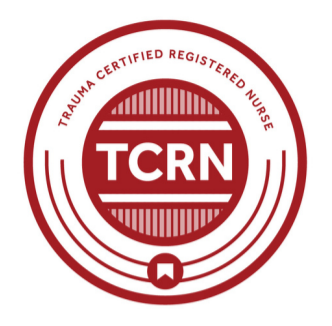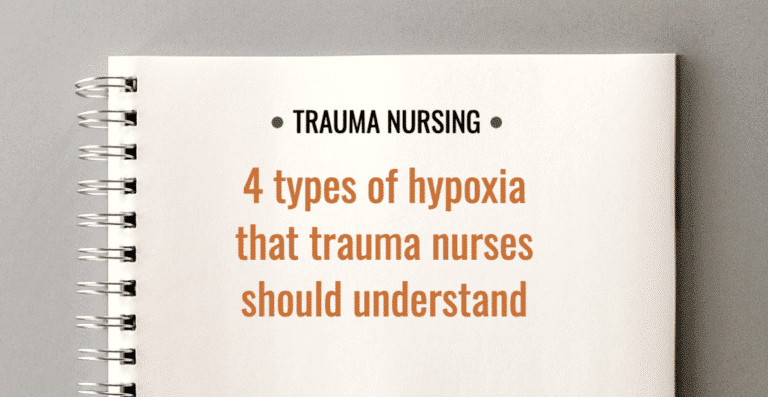Hypoxia is any state of low oxygen within body tissues. If the oxygen insufficiency is severe enough, it can be life-threatening. Most commonly, this life-threatening low oxygen state leads to systemic acidosis in the body, complicating clinical treatment and, ultimately, recovery.
Trauma and emergency nurses should know the different causes of hypoxia and the related treatment strategies.
1. Hypoxic hypoxia — not enough oxygen enters the body
The most common form of hypoxia is hypoxic hypoxia. It occurs when not enough oxygen enters the body, either because of low oxygen levels in the environment or because a medical condition reduces the ability of the lungs to take in oxygen.
Hypoxic hypoxia caused by a low-oxygen environment. The oxygen saturation of the air decreases as elevation above sea level increases. This effect is important for mountain climbers, but the most common impact is on airplane passengers. Commercial airplanes are pressurized to match an altitude of 8,000 feet above sea level, which represents a 4% to 5% reduction in oxygen saturation. Most healthy individuals can tolerate this drop in available oxygen, but it can cause problems for people with a cardiopulmonary condition. Treatment: Descend to a lower altitude and/or provide supplemental oxygen.
Hypoxic hypoxia caused by a medical condition. Pneumonia, pulmonary emboli (PE) and acute respiratory distress syndrome (ARDS) can all reduce the surface area of the alveoli, the tiny air sacs in the lungs. This reduces the ability of the alveoli to exchange gas, thereby reducing the diffusion of oxygen into the lungs. Treatment: Provide supplemental oxygen and treat the causative pathology.
2. Hypemic hypoxia — the blood cannot carry enough oxygen
Hypemic hypoxia occurs when the blood is unable to carry sufficient oxygen. The most common causes of hypemic hypoxia are anemia and carbon monoxide poisoning.
Hypemic hypoxia caused by anemia. There may be enough oxygen in the atmosphere and the lungs may be working perfectly, but the patient with anemia does not have enough red blood cells to transport oxygen throughout the body. Treatment: The current practice is to transfuse packed red blood cells (PRBCs) when hemoglobin is at or below 7 g/dl. If the patient’s compensatory mechanisms are insufficient, transfusion may be warranted at a higher base hemoglobin level. (Note: If the patient is actively bleeding, the time lag between blood draw and lab results may lead to an overestimation of actual hemoglobin levels.)
Hypemic hypoxia caused by CO poisoning. The hemoglobin-CO affinity is more than 200 times greater than the hemoglobin-oxygen affinity. This means that when CO is present it will easily replace oxygen on hemoglobin, blocking the ability of red blood cells to bind with oxygen. Note that pulse oximetry may show 100% saturation, but this reflects that hemoglobin is saturated with carbon monoxide, not oxygen. Monitor carboxyhemoglobin levels to guide treatment decisions. Treatment: Administer 100% oxygen.
3. Stagnant hypoxia — there is not enough blood flow to deliver sufficient oxygen
Stagnant hypoxia occurs when the cardiopulmonary system and/or the circulatory system are unable to circulate enough oxygenated blood throughout the body. Common causes include:
- Shock of any type, which is the acute reduction of blood flow to a life-threatening level
- Sickle cell disease, in which sickled blood cells can block the flow of healthy red blood cells
- Hypothermia, which causes the blood vessels to constrict
Treatment: The initial treatment is supplemental oxygen. Additional interventions are aimed at treating the underlying cause and providing supportive care. If patient condition deteriorates, non-invasive ventilation or mechanical ventilation may be necessary.
4. Histotoxic hypoxia — oxygen is delivered to cells, but the cells cannot use it
The main overall cause of histotoxic hypoxia is poisoning. The most familiar scenario is cyanide poisoning, which prevents cells from using oxygen. Cyanide toxicity typically results from smoke inhalation in an industrial setting. Treatment: Hydroxocobalamin (Cyanokit).
Note: When treating patient with suspected cyanide poisoning, the safety of medical providers is the first priority. Treatment should not begin until you are certain the threat of exposure is contained. Do not touch a patient with suspected external exposure until you are certain they have been decontaminated.



